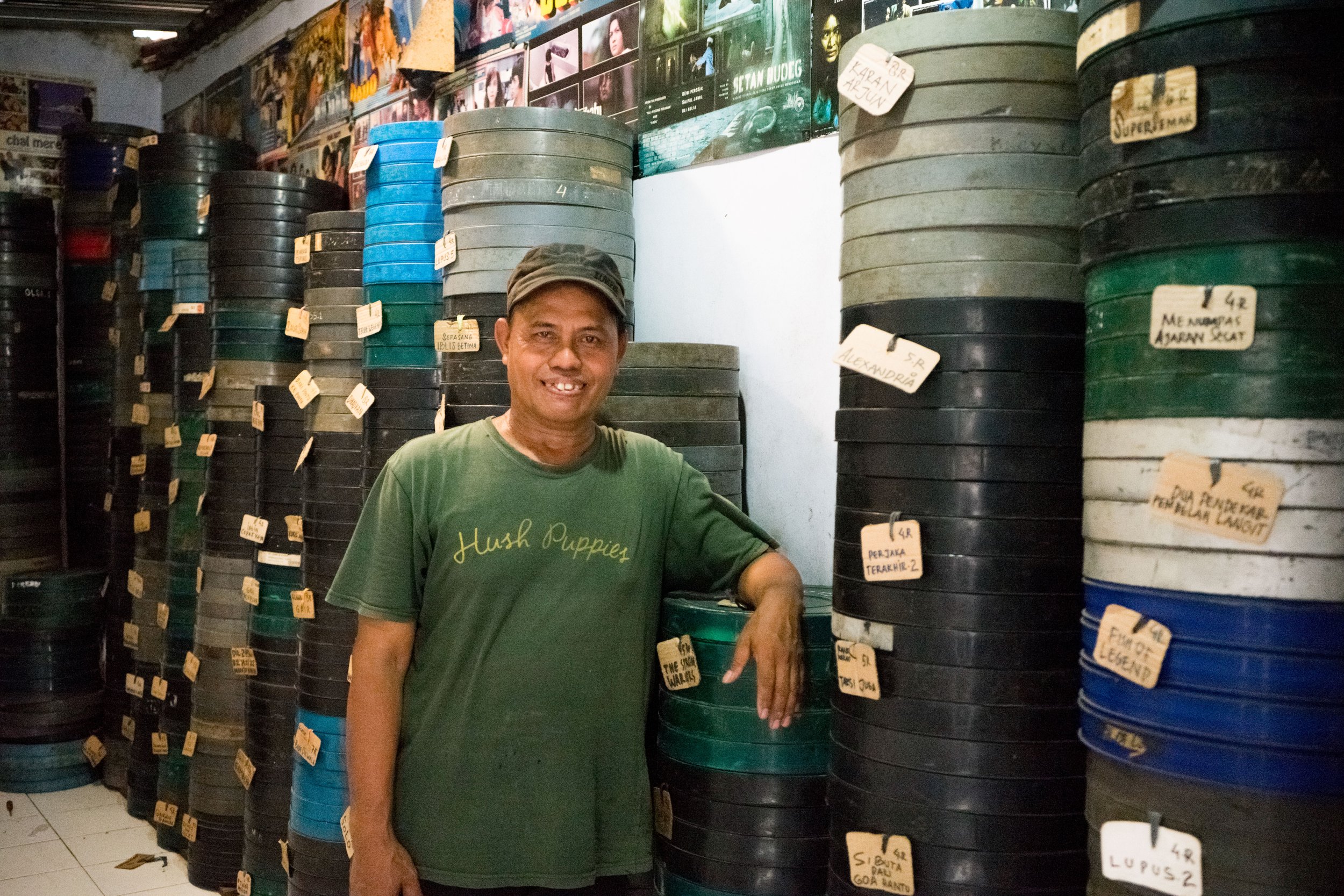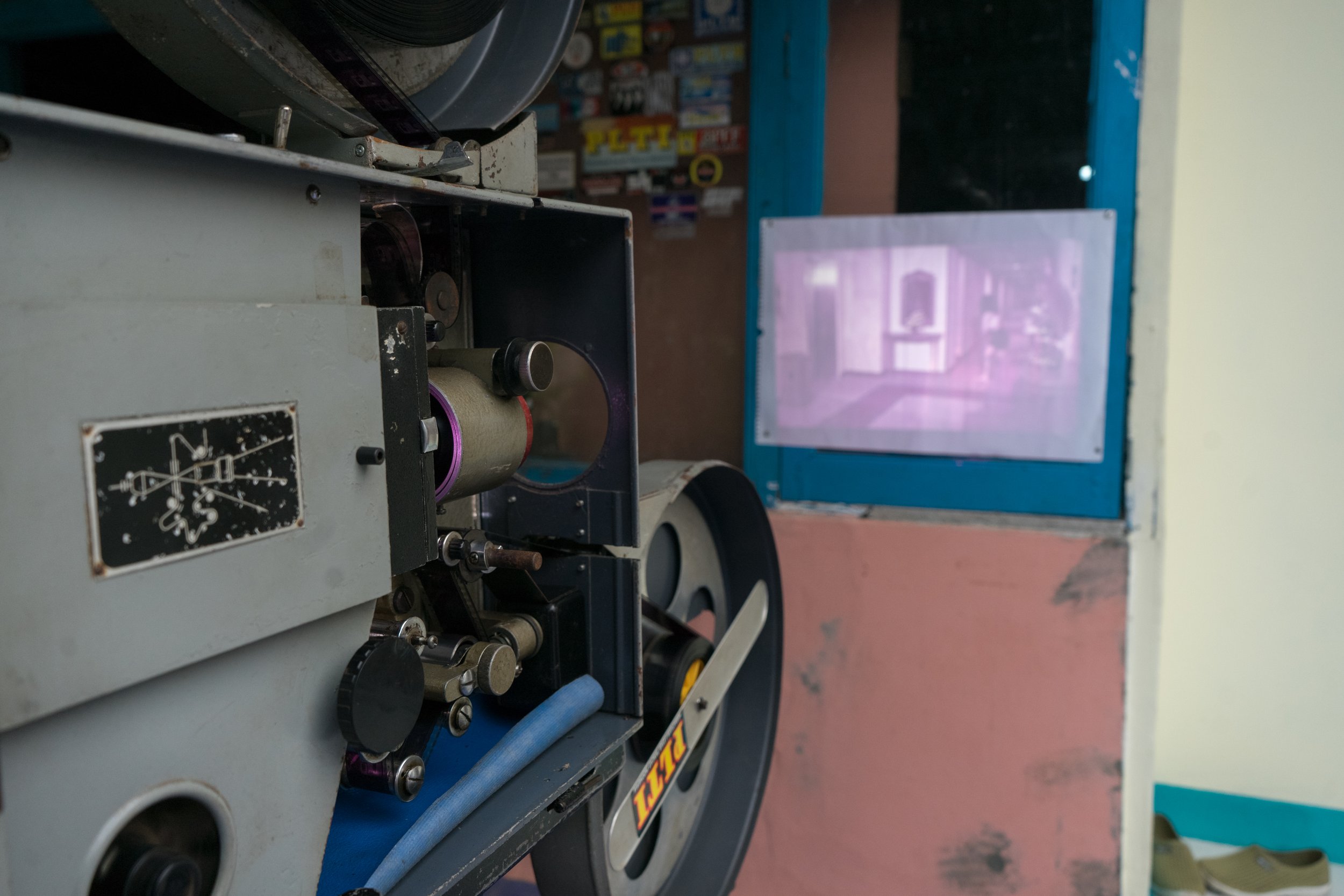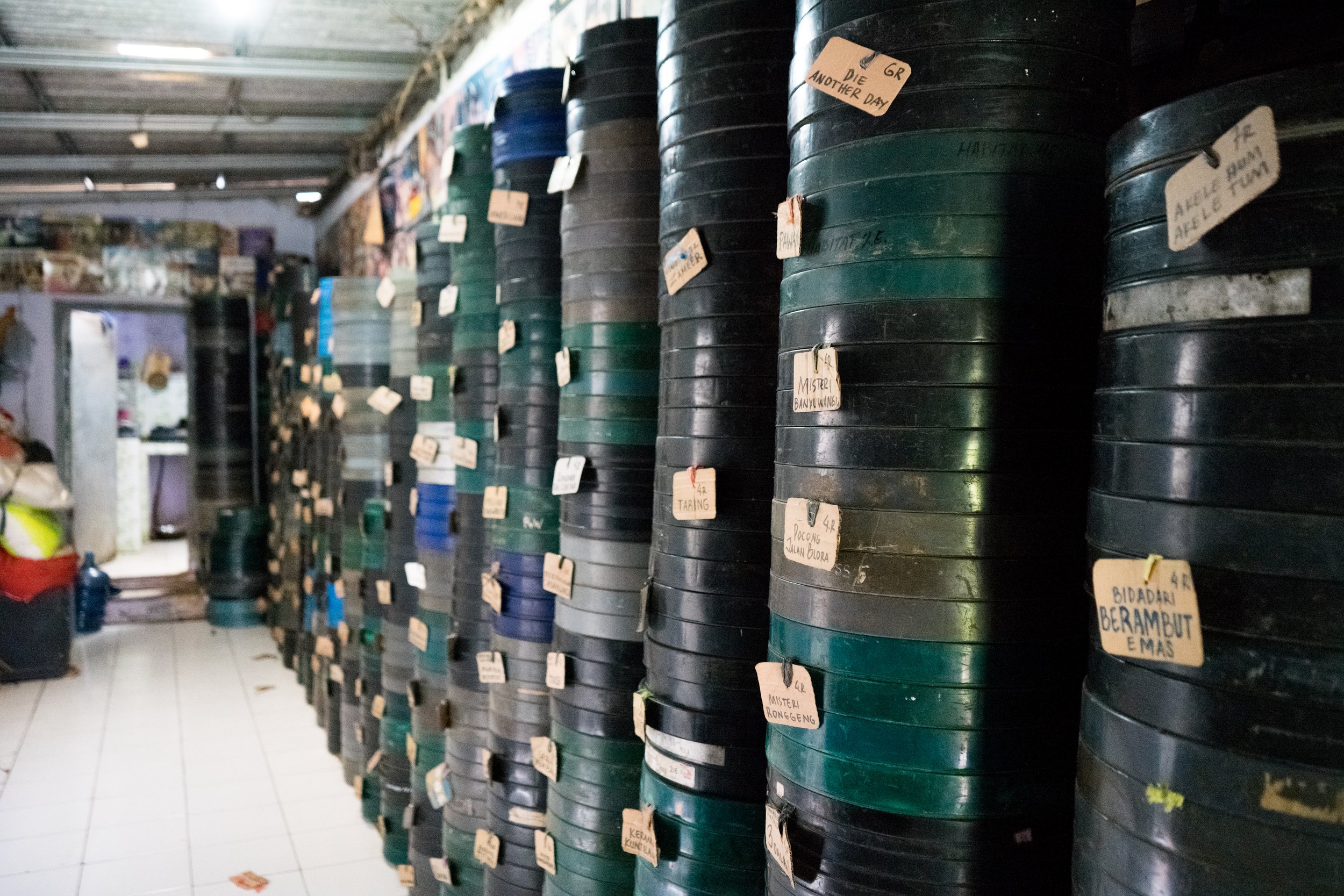Guerilla outdoor cinema: People’s cinema and its waning popularity
Written by Ardela Nabila | Read in Indonesian
Hundreds of 35-millimeter (mm) celluloid movie reels were neatly stacked inside Nur Iyan’s home. The 51-year-old man is a guerilla outdoor cinema service provider based in Pamulang, South Tangerang city. Amidst the rise of modern cinema, Iyan remains devoted to his old 35mm film projector.
Iyan told TFR that he has liked guerilla outdoor cinema since he was a child. His first tool was a used 35mm film projector that he bought in 2004 from a cinema in Pasar Minggu.
When the Indonesian cinema industry went through a massive technology transition and started adopting new, more sophisticated equipment, many guerilla outdoor cinema providers like Iyan bought used equipment from various cinema chains, as can be seen in the picture gallery below (Documentation: Syevira Citra).
“In 2005 I started collecting movies and now I have a collection. There are Western, Mandarin, Indonesian, Indian, Thai movies in various genres. The movies were from the 1970s to 2013,” said Iyan, who once worked as a public passenger car driver.
Today, his collection has reached 500 titles, making him one of the most influential people with the largest movie collection among other guerilla outdoor cinema providers under the Layar Tancap Indonesia Association (PLTI).
The PLTI was founded in 2014 as a forum for interaction for guerilla outdoor cinema operators and businesses. It has 20,000 people from all over Indonesia. Iyan was a senior in the community, serving as vice president.
Guerilla outdoor cinema has existed in Indonesia since the 20th century–in 1901 to be exact. In the beginning, it was used for propaganda by the Dutch East Indies colonialists to spread their ideology. In 1942, the Japanese government also used this media for the same purpose.
Entering the 1960s, guerilla outdoor cinema rose to prominence when commercial cinemas started entering Indonesia. This is because guerilla outdoor cinema became an alternative for urban people to enjoy cinema at a more affordable price.
The Indonesian term for guerilla outdoor cinema is layar tancap, describing its installation where people watch movies on a big screen made out of cloth stuck on two bamboo poles embedded into the ground. Layar tancap is also known as mobile cinema because the operators must travel from one place to another according to the customer’s order. Another term is misbar, or gerimis bubar (disperse when it drizzles), used to describe how the audience will disperse as soon as it starts to rain.
Still thriving in the midst of modernisation
Despite having been slowly forgotten by the younger generation who prefers watching movies in cinemas, the popularity of layar tancap is still high among village residents. This is apparent from the huge number of orders that Iyan receives every day.
“In villages, there are still many people who use layar tancap, for khitanan (circumcision celebration), weddings, even birthdays. Every day, praise be to God, I make some money. In a month I can screen around 50 movies. During peak times like in August, I can rent 100 movies,” Iyan said.
Iyan set the price of his service at Rp2 million-Rp5 million, depending on the distance of the screening location as well as the equipment required.
Classic movie enthusiast Harry Hariawan said that recently, layar tancap is regaining its popularity.
“If it is said to be fading, it is indeed true. But recently it is regaining popularity due to the vintage trend. Many people started to inquire and got interested in how people from the old times watched movies,” said Harry, who is also part of Kineforum, in a separate interview with TFR.
In the past, people sought layar tancap because there were no other options to enjoy movies. But today, layar tancap exists for those who want to feel the sensation of watching a movie in a more “down to earth” manner in an outdoor setting.
“Layar tancap today is more like selling the experience, not a regular show. Over these few years, there is an uptrend. It is the same with music, even though there is a digital streaming platform, people return to vinyls,” he said.
Iyan shared a similar opinion. “The gap is indeed wide (with cinemas). If we are watching a movie in an open space, on layar tancap, if there is a funny scene we can laugh together and cheer. So we are more free to express ourselves.”
In addition to it being a hobby, this is also the reason why Iyan insists on keeping his layar tancap business.
Together with the PLTI, Bang Iyan–as he is familiarly called– also actively holds layar tancap events to preserve the existence of analog cinema in Indonesia. One of the most actively held events is Layar Tancap Festival, where PLTI members gather and screen movies simultaneously in more than 10 layar tancap.
“I will keep on preserving this business until the end, because people who are enjoying layar tancap all have different purposes. There are those who want to reminisce about their past, there are those who want to watch old movies,” he added.
Offering an irreplaceable sensation
For classic movie enthusiasts like Iyan and Harry, the experience of watching a movie from celluloid film reels cannot be replaced by modern cinema.
Technology has made it possible for movie enthusiasts to watch two-dimensional visual works of art from the palm of their hand, but both Iyan and Harry still stick to analog films.
Aside from the risk of strong wind and heavy rain which often toppled or even tore down the screen, the two of them thought that everything that has to do with celluloid film is art.
“There is a saying that this (analog film) is the original, it is an art. The sound of the machine when the movie is played, that is the art. There is a certain difference compared to modern equipment. We can spin the machine. It has a unique sound, that is the art,” said Iyan.
As Harry explained it, “The sensation of watching a movie from a 35mm reel is irreplaceable. Today, with digital [technology], anyone can watch, just push the button and it is so easy. But 35mm can be said to have a different sensation, more complicated because the equipment is big, the movie is played from a reel. It can be said that layar tancap is people’s cinema. There is also a sort of experience from the sound when the reel is being played which gives off a particular feeling. The feeling is different, when it’s projected, it’s sharper.”
With vintage projectors, one film reel contains 17 to 20 minutes of a movie, so for an entire movie, we need to play three to four reels. That is why patience in taking care of each film reel is needed.
Iyan and Harry hope that layar tancap can be preserved and known by the future generations.
Reel film archiving and collaboration with various parties in the movie ecosystem is very essential to preserve the form as well as the culture of watching a movie in this very down to earth way.
“Teamwork involving the community, the government and other parties such as movie archivers, movie workers, is needed. Movie restoration workers also have a very important role, because they are the ones who can help restore the film reels (for layar tancap) to a prime condition like new,” Harry concluded.























